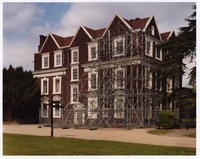Boris turns heritage at risk into homes
 On the day (Tuesday 8 July) that English Heritage launched its new Heritage At Risk Register, London Mayor Boris Johnson, announced that he would use the register to help bring London’s listed buildings at risk back into use as much needed housing. The Mayor has £331 million to spend in his Targeted Funding Stream for Housing and as part of that funding, £60 million has been earmarked for bringing London’s empty properties back into use.
On the day (Tuesday 8 July) that English Heritage launched its new Heritage At Risk Register, London Mayor Boris Johnson, announced that he would use the register to help bring London’s listed buildings at risk back into use as much needed housing. The Mayor has £331 million to spend in his Targeted Funding Stream for Housing and as part of that funding, £60 million has been earmarked for bringing London’s empty properties back into use. Long-term dilapidated and, for the first time, listed buildings have been identified as a priority. The Mayor wants owners of listed buildings on the English Heritage’s At Risk Register to work with their local authority to bid for money to improve the condition and use of their properties for housing.
There are currently 572 Buildings at Risk in London, 50% of which are empty and could be brought back into use. Of all the buildings on the Register, 210 are residential buildings, 140 (67%) of which are vacant and 42 (20%) of which are partly vacant.
Residential listed buildings in London which could be refurbished range from a Victorian villa in Enfield a Gothick country house in Ealing, to even the remains of a Wren church in Upper Thames Street in the City.
There are also many non-residential listed buildings on the At Risk Register which could be successfully converted into housing with the help of English Heritage advice. These include a 19th century sailmakers and chandlers in West India Dock Road and a former workshop and engineering works in Park Street, Southwark.
Making the announcement from a derelict historic building in Swinton Street Street, Mayor Boris Johnson said: “I believe, like English Heritage, that London’s heritage is possibly its greatest asset after its people. Buildings like these must be made to live again, to serve as much needed housing and to give character and dignity to our streets. I am not prepared, as Mayor, to stand by and see history, in the form of buildings like these, hit the skip.”
Simon Thurley, Chief Executive of English Heritage, who joined him to welcome the announcement, said: “This is the best news for London’s heritage at risk since we began compiling our Buildings at Risk Register in 1998. The fact that the Mayor of London is throwing his weight behind the repair of these buildings is a tremendous encouragement to all who believe that our historic environment is too vital a resource to let go to waste.
“These buildings are irreplaceable parts of our heritage and there are powerful economic, social and environmental grounds for recycling them for current and future generations. I would urge every civic leader in the country to follow Mayor Johnson’s example and use our Heritage At Risk Register to prioritise their own funding. In doing so they will be saving their communities’ history, rescuing its pride and identity and providing inspiring new spaces for local people to live and work in.”
London entries on the Heritage at Risk register can be viewed at english-heritage.org.uk/HAR.
Owners who are interested in bringing their empty property back into use should initially contact their local authority. They should also seek the advice of their local authority Conservation Officer at the earliest opportunity to find out how their property could be restored. Local authorities and housing associations who wish to bid to the Targeted Funding Stream should contact the London Development Agency. English Heritage will usually become involved in helping with proposals for major changes to Grade I and II* buildings and large-scale schemes.
English Heritage first published the Buildings at Risk Register in London in 1991. Since then 92% of the original buildings on the register have been saved and removed. The larger Heritage at Risk Register launched today aims to expand this winning formula to all other elements of England’s protected heritage over the next few years.




